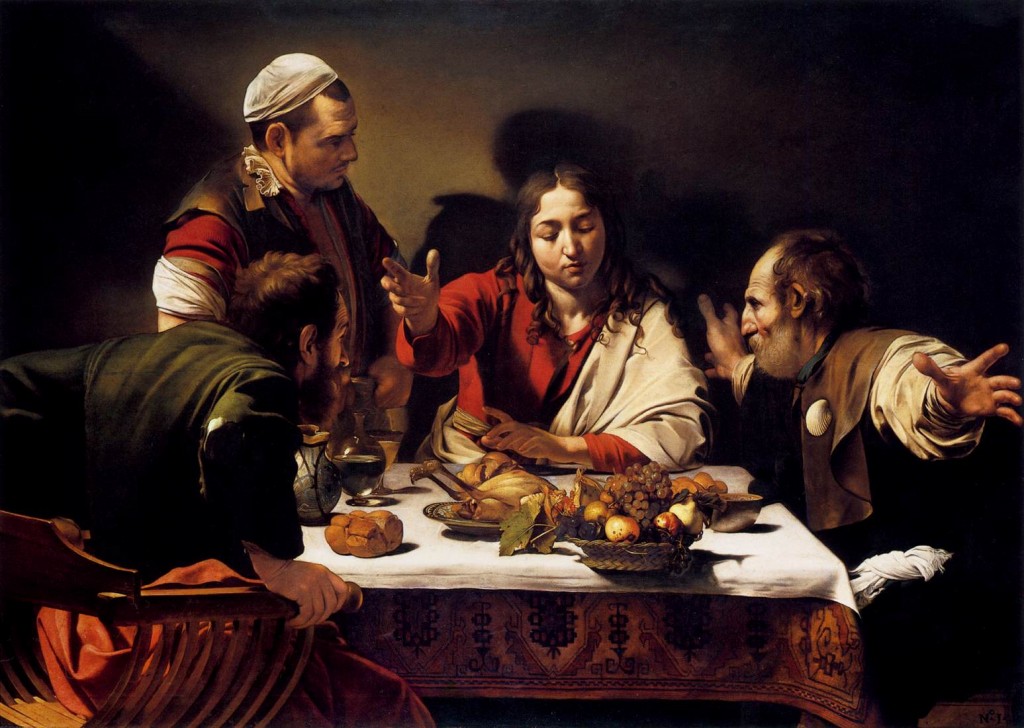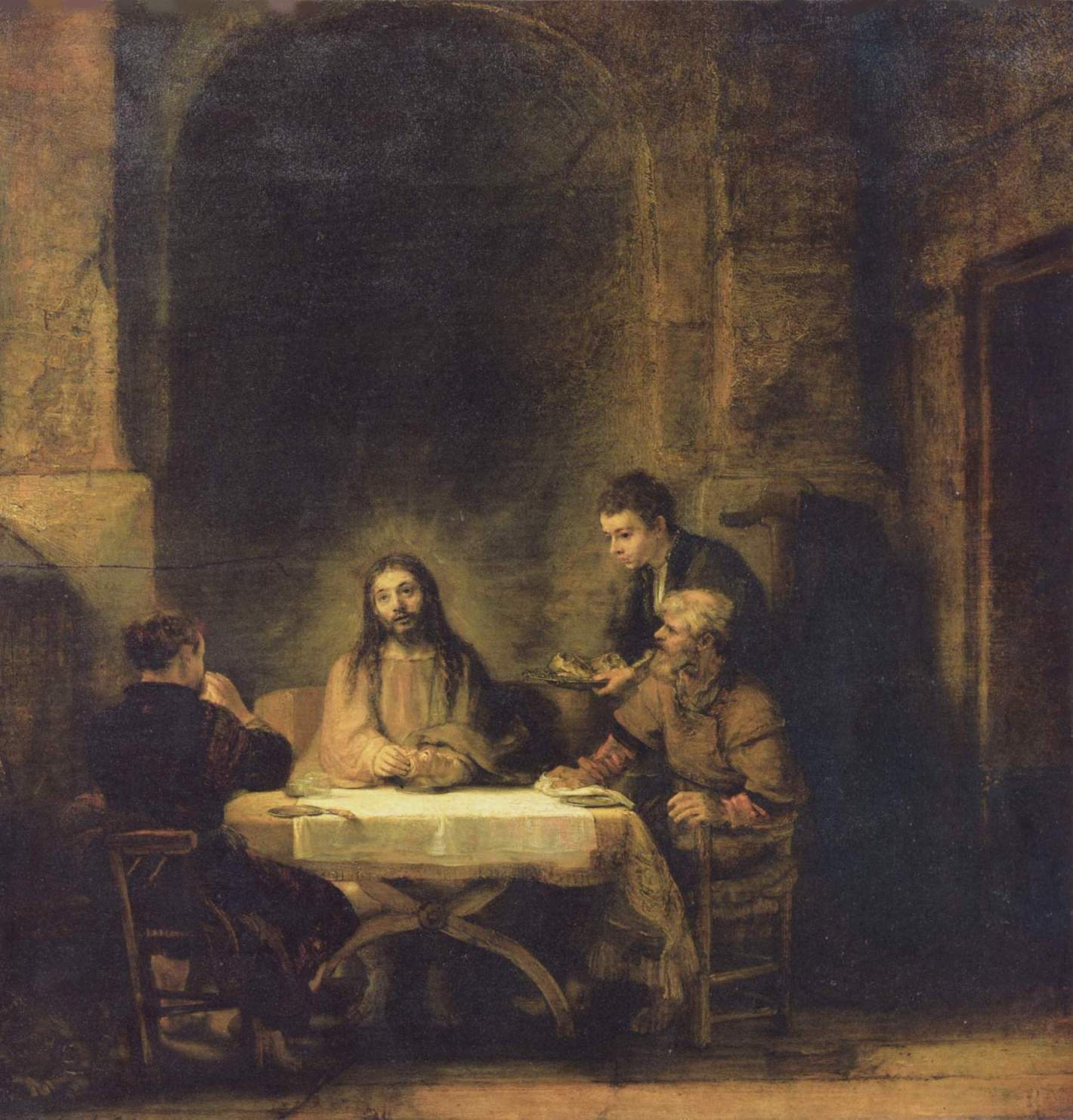Art and the Church


Supper at Emmaus by Caravaggio and Rembrandt
Word and Image Bible Study based on Luke 24:13-34 and Supper at Emmaus by Caravaggio and Supper at Emmaus by Rembrandt
Target Group For small groups or personal study.
This study uses a comparison of two paintings both entitled Supper at Emmaus, by Caravaggio (Figure 1) and Rembrandt (Figure 2) respectively, in dialogue with the text to help us come to a greater understanding of Jesus' encounter with the two believers at Emmaus. Although these paintings focus on verses 29-31 of Luke 24, the whole passage will be considered in light of these paintings.
Aim Indeed that is what we seek through this study: new light that can be cast on the text in Luke 24 through the consideration of these paintings, which are images representing the painters' readings of the text. Thus our own reading of the text – acknowledging there are often many possible emphases, nuances and aspects to see in any biblical text – dialogues with these other readings and the text itself.
Scripture reading Read the text in Luke 24: 13-34. Discuss the questions below.
Questions
1. Briefly discuss your initial responses.
2. Identify what's going on in this passage:
a. What are main events?
b. Who is present in the passage?
c. How is Jesus presented?
3. What key themes do you see in this passage?
4. In what ways does the meal at Emmaus echo the Last Supper?
The paintings If possible, project the paintings onto a large screen, a computer or television screen. Or look the paintings up in a book. Take a few minutes to look at each painting in silence. Do not discuss them immediately. Throughout the study questions will be posed in black, while answers are rendered in blue. With each question take time to reflect and discuss before you read the explanatory blue passages.

Caravaggio (1571-1610) painted Supper at Emmaus in 1601, while he was living and working in Rome. This is not the only work of Caravaggio on the subject of Emmaus. Caravaggio typifies a style consistent with the Venetian style developed from Titian.

Rembrandt (1606-1669) painted Supper at Emmaus in 1648. It is also one of several paintings he painted of this scene. The Emmaus Road account was one of Rembrandt's favourites and one which he revisited several times over the span of his career, more so in the period where his commissions had slowed. The painting in this study was painted in this later period and may have been in Rembrandt's mind as a piece to be sold in the open market.
1. Compare and contrast the two paintings: what is similar and what is different? Pay attention to painting style, the composition in terms of how the scenes are arranged, what each person is doing (body language, gestures, facial expressions), contrasts between light and dark, and colour.
Caravaggio depicts Christ as he raises his right hand to bless the yet unbroken bread, with the two disciples recognizing him and the innkeeper looking on.
Rembrandt alsodepicts Jesus with the two disciples just at the point they realize who he is. The boy serving looks on, seemingly oblivious. The depiction is of a humble and ordinary everyday scene but light emanates from the risen Jesus, the extraordinary in this scene.
2. Look again at the Caravaggio. What do you consider the role of the different items of food and drink on the table to be? If these are symbolic, what do they represent in relation to the Emmaus account?
Not only are there the blood and water presented which Christ had shed, but also the fruit is significant. The bunch of grapes echoes the wine, the apples perhaps connote the Fall and the pomegranate alludes to the crown of thorns. The focus is on the symbolism within the picture, which makes it something of an iconographical piece. This is an overtly Counter Reformation painting where Christ is connected with the bread, echoing the Roman Catholic doctrine of transubstantiation (the bread becomes the very body of Christ when blessed by the Priest).
3. Rembrandt's depiction is bereft of similar details, but Jesus is depicted with a halo and is emanating light. What do you think this is communicating? How does this contrast with Caravaggio's portrayal of Jesus?
With Rembrandt Christ is presented as the Light of the World, one who removes spiritual darkness and enables us to see God. Very much more an Immanuel – God with us.
4. Both paintings depict the moment of recognition by the disciples that it was the risen Jesus. This happens in slightly different places in the narrative according to each painting. How do Caravaggio and Rembrandt then ultimately read (or interpret) the meal at Emmaus? What is their respective overall take on what was happening?
With Caravaggio Christ is presented as the one in whom we participate through the Eucharist, the Lamb of God bringing redemption from the Fall through his sufferings.
For Rembrandt, in contrast, the scene depicted seems to be much more about the inner spiritual experience. The scene is much emptier of objects but it is the light, primarily emanating from Christ, which is of significance here. The light signals the recognition of the disciples at the table, the dawning recognition that this is the same Christ, yet risen. Moreover, the light reflects the way in which Christ, the Light of the world, sheds light on humanity's inner spiritual darkness.
Final questions
1. How does this Emmaus road episode help you in your understanding of who Jesus is?
2. When you go back to the Bible text again, have these two paintings represented it in a good manner?
3. A key theme in this passage is revelation and the opening of our eyes. How do both of these function in our lives?
4. Try to place yourself in the shoes of one of the disciples with Jesus that day. What do you think it would have been like? Has your heart ever 'burnt within' you when seeking God in prayer, Bible study, a sermon or some other worship context? If so, what happened?
This study is prepared by Richard Evans, student at Regent College, Vanvouver B.C., Canada.


